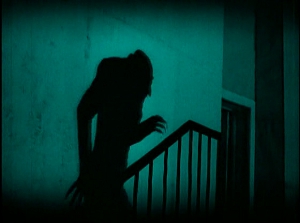
Here it is, then: Vampire Movie Zero. As far as anyone can tell, this is the first cinematic adaption of the Dracula and the film that popularized vampire mythos more than anything since Bram Stoker’s original novel. Studied by film students, poured over by professors, homaged by professionals and commentated upon by ninety years worth of talking heads…it’s too bad the damn thing’s so rarely seen. By people, I mean, out in the really-real world. If more people saw this, they might demand more from their vampire fiction, because they might realize how little its really moved, even after all this time.
If Stoker’s estate had anything to say about it, we would’ve never seen this film at all. Its producer and costume designer, Albin Grau, first heard a tall tale about a vampire from a Serbian farmer while serving on that front in 1916. After the war, he returned to Germany and founded the studio Prana Film for the express purpose of making a vampire movie. This one.
Problem: Stoker’s estate still owned the rights to Dracula, which had been adapted to the stage several times in the twenty-five years since its publication, but never filmed. (Again, as far as we know – something like half the films made in the Silent Era are officially lost to us.) Solution? Change everyone’s name (Mina became “Ellen,” Jonathan Harker became “Hutter,” Count Dracula became “Count Orlock”) and set the story in 1830s Germany. Surely, they thought, that will stave off the lawyers! It didn’t, and lawsuits followed, eventually bankrupting Prana Film and requiring all prints of Nosferatu be destroyed. Thankfully, that genie’d already escaped via several international distributors and several (often low-quality) nitrate stock copies.
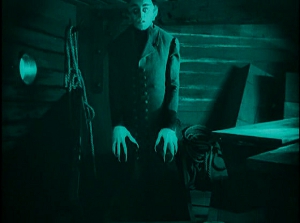
Some of these even translate the inter-titles incorrectly, re-christening characters with the very names Grau and screenwriter Henrik Galeen originally changed. So Im’ going to play cute with that fact for the rest of this review with almost every character…save Orlock himself, of course. I might be crazy, but I’m not stupid and I sure as hell don’t want to incur this count’s wrath. Even compared to other vampires Orlock’s still a Grade-A Badass and anyone who says different is probably an unironic fan of the Twilight franchise.
It’s an old story, but I’ll tell it again. Not-Jonathan Harker (Gustav von Wangenheim) is the clock-punching peon of a local real estate firm in the quaint little (fictitious) town of Wisborg, circa 1838. As our story opens (literally), Not-Jonathan’s boss, Knock (Alexander Granach), dispatches Our Hero to the Carpathian mountains, where a certain Transylvanian count sits ready and waiting to sign a fist full of purchase agreements. Knock charges Not-Jonathan with selling Not-Dracula the dilapidated row of houses across the street from Not-Jonathan’s. What could be the harm in that? Besides, they’ll be a big fat payday at the end of this arduous round-trip.
Not-Jonathan goes home and breaks the news to his wife, Not-Mina (Greta Schröder) in more or less the worst possible way:
“I must travel far away, to the land of thieves and phantoms.”
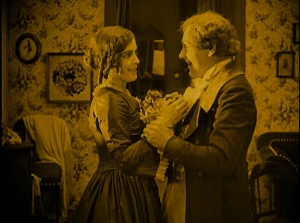
Dude, you might want to at least try and sweeten the deal. For your wife’s sake, man; c’mon! Be all like, “It’s cool, hon. We’ll both get a nice, long vacation out of this and Amsterdam’s just a short train ride thata’way. We’ll be swimming in pot and prostitutes as soon as I get back, I promise! You know they’ve got all the colors of the rainbow in that Red Light District…and hey, if you’re feeling frisky, you always stick with me on this trip…take a walk on the Sapphic side, eh? You keep teasing you were a two-beer bi back in your carefree college days, so I’ve been thinking…”
You see the difference in approach there? I’m just sayin: you catch more flies with honey.
So after promising his wife only the best in Dutch hospitality (or maybe I’m projecting), Not-Jonathan leaves her with the childless married couple next door, who I’m sure’ll make Not-Mina feel right at home. It’s interesting: other adaptions of this story almost never spend this much of time with these two as a couple. Even Stoker, great Gothic bad actor that he was, seem to say, “Fuck this middle-class domesticity bullshit! Let’s get to the vampire!”

So fuck this middle-class domesticity bullshit. Let’s get to the vampire. Or at least to his mountainous homeland, with its quite towns and superstitious peasants. After silencing a tavern-full of ’em with news of where he’s bound and hearing rumors of a marauding werewolf (looks more like a dingo to me, but whatever) from the local Wilford Brimley impersonator, Not-Jonathan retires to bed with a quaint and curious volume of forgotten lore called Of Vampires, Terrible Phantomes and the Seven Deadly Sins. Which reads in part
“From the seed of betrayal sprang the vampire, Nosferatu!”
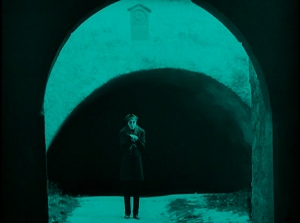
You’d can’t get much more Gothic than that without being a Bronte sister. The next day, Not-Jonathan’s stranded at Not-Borgo Pass, meets the Count’s “driver” (who has the power to speed up the frame rate and temporarily shift the movie into the Negative Zone) and soon, the Count himself (Max Schreck of the Reinhardt Company).
What’s left to be said about Orlock? He’s one of the most influential vampires ever filmed and still the creepiest, even after inspiring a whole line of vampires with his various aesthetic trappings. Between his rat teeth and his bat ears and his uncomfortably long fingers he manages to hit that sweet spot in the Uncanny Valley all movie monsters should aim for if they’re trying to actually appear monstrous. Schreck’s body language seals the deal his makeup and costuming opened up, injecting eery purpose into a stiff pantomime of a walking corpse that puts every zombie in cinematic history to shame (save for a few in the original Night of the Living Dead).
The rest of the movie proceeds as you’d expect: Not-Jonathan accidentally cuts himself at dinner, causing the Count to do his best impression of a crack addict and ask Not-Jonathan to “stay together a little while longer, my lovely man.” Not-Jonathan wakes the next morning with two puncture marks on his neck, which he initially mistakes for mosquito bites. A quick re-reading of Of Vampires, Terrible Phantomes and the Seven Deadly Sins and the Count’s strange, nocturnal existence cast doubt upon that ultra-rational hypothesis. Especially once Not-Jonathan sees Orlock rise from that coffin in the castle basement…
As with its source novel, Nosferatu leads well with a strong first act…that the rest of the story can’t really live up to because the first part is so damn good. Once we get to the Count’s crumbling home we’re at the nadir of Gothic Horror and should, by all rights, go no further. How much further could we go? Along came Bram Stoker, insisting, “No! I will drag this horror back into a sunlit, middle class world my audience will instantly recognize as their own. Then I’ll have them by the balls!” Except…no, Bram, you really won’t. We want to be back there, in that castle, with Not-Jonathan, on the knife edge of realizing we’re trapped in a Very Bad Place where nightmares literally walk the Earth (sometimes as werewolf-dingos). Placid domesticity pales in comparison to that, especially since the film went out of its way to set that domesticity up at the start.
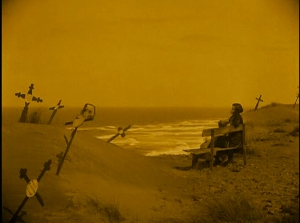
But, in a strange case of faithfulness to source material, Nosferatu spends its middle half cutting between the real action and Not-Mina’s pining away for her Distant Love with…I guess they’d be Not-Dr. Steward and Not-Lucy Weston. And I must say, Not-Mina, whose “real” name is Ellen, picked the best spot to stare out to sea and wait for word of her hubby. What was the name of that place? Shark Attack Point? Or were those crosses all planted to honor the victims of boating accidents?
Gratefully, Grau, Galeen, and director F.W. Murnau knew the real horror of this situation lay with Not-Jonathan’s escape from the castle and his arduous trek across Europe by foot. Contrasted with Count Orlock’s journey by sea, it becomes a race against time for the both of them, each looking to bring their own breed of unhappy tidings back to the bosom of “civilization.” And since this is a full-blown symphony of horror, we know who’s going to win from the get-go.
That’s okay, because Murnau lavishes the same care and attention on the doomed sailors and helpful nuns that he lavished on Our Loving Couple. After the castle sequence, the Count’s bit of action at sea is my second favorite part of the movie. This Dracula may not transform into a bat, but he seems to command an army of rats, and that’s even worse for most people (myself included – bat’s don’t frighten me, I actually admire them – they’re great survivors). There’s a scene where a sailor hacks a coffin open, and a stream of rats (thousands…millions of them) pour out of the box like harry, wriggling gumballs from a broken machine. Then Orlock pops out of the next coffin over, driving the sailor to jump overboard rather than face the horror.

Orlock and his rats bring a plague down on Wisborg – perfect cover for a vampire on the up and up. Do you want to talk about combining domesticity with Gothic horror? There’s a shot in here of Orlock carrying his own coffin (under one arm, no less) off the ship and stalking calmly through the night time streets to his new abode across from the Not-Harkers. Discuss.
All these horrible goings on cast a pall over Not-Jonathan’s return and a shadow over Ellen’s mind. Already haunted by the advancing urban decay visible across the street:
“That is what I look at every night!”
it seems there’s no end to the modern social ills around here. Must we deal with them on top of all these Vicious Foreign Invaders? Well…if we’re Germany in 1922, the answer is sadly, “yes.” They didn’t know it at the time, but things had not yet begun to suck…yet you could still see easily see this film as a war parable. Not-Jonathan’s the picture of an upstanding, All-German soldier: believing in his cause so hard it blinds him to the obvious Hell he’s voluntarily walking towards. Ellen’s the virtuous homemaker every young man was supposed to go into the trenches for…beautiful, sure, with great hair and the bedroomiest bedroom eyes on this side of the Rhine River…plus, to top it all off, she’s smart.
Rifling through her husbands things, she comes across Of Vampires, Terrible Phantomes and the Seven Deadly Sins and (here’s the important part) reads all the way to the end. Where the book helpfully explains the proper way to kill a vampire: have a young maiden with a pure heart distract the damned thing until sunrise by allowing it to drain her dry. Putting two and two together, Ellen opens her window, faints, gets revived by her husband…and then sends him out for Not-Van Helsing (who barely appears in the film at all) so she can make the save, destroying the monster in a puff of smoke and a grand death scene for the both of ’em. What more could two stars ask for?

I actually like Ellen more than the Mina we got to know in Stoker’s novel since Ellen does more than lay around loosing blood drained while the bodies of her friends pile up around her. Once she has something to do other than sit on the seashore she’s as proactive and self-sacrificing a protagonist as you could want. Where’s this Mina been for the rest of the twentieth century? I can totally see Allan Moore putting this woman in charge of the League of Extraordinary Gentlemen.
Yeah, the film’s method of vampire disposal is a bit Grimm’s Fairy Tale…but I don’t know what else to expect from a pack of Modernists like this. The whole film feels like a fable, and the 1830s setting may be an intentional call-back to that very literary legacy. If so, more power to you, Prana Film. Sorry you never got the chance to make a second feature. (Lair of the White Worm, maybe…couldn’t have been worse than that one they made in the 1988.)
No movie’s perfect, not even this one. The pacing is pretty lopsided, with a tense first half, a muddled middle, and a grand race to the awesome end – but that was a problem the source material had in spades. As an adaption, Nosferatu does what good adaptions should do and use the techniques of a new medium to improve – not the story – but the telling of it. As a film on its own, Nosferatu lives up to its subtitle. It’s a (un)living piece of horror history that deserves to be seen, studied and celebrated. If I were you, I’d use that Amazon link in the upper right column, buy myself the Ultimate Edition, hunker down in the middle of the night with all the lights turned off, and half myself a good ol’ time.
And if I were you but luckier, I’d invite someone of your preferred gender over for a private symphony of their very own. After all, as Martin Landau’s Bela Lugosi taught us in Tim Burton’s Ed Wood,
“If you want to make out with a lady, take her to see Dracula.”
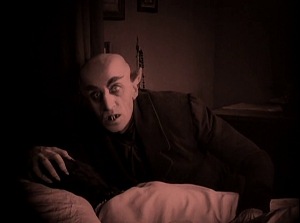
![]()
![]()
![]()
![]()
![]()

I can’t watch this anymore without thinking of Shadow of the Vampire. It’s the rare case where a ‘behind the scenes’ movie makes the actual movie even better.
Anyhoo, Nosferatu holds up. How many movie can you say that about after (gasp) 90 years? Schrek defined the vampire until Bela Lugosi, and vampire flicks ever since have moved along a spectrum between the two (except for Romero’s Martin, which I won’t bring up since it might spoil my wonderful analogy.) And it’s still scary, which makes it even better. Everyone knows the scene with Orlock rising from the coffin… because 90 years later, it still works.
I love the ship scene, and I’d like someone to give this film the credit its due outside of horror nerd circles: it invented the “sunlight kills Vampires” meme. Prior to this film legends just had vampires unable to come out in the light, or weakened in it.
I didn’t love this until I saw it with the Alloy Orchestra providing a live soundtrack-man was that good. The first time I saw it, it was on a terrible VHS copy, with a droning organ soundtrack. Though I admit, as I went out to collect money from my paper customers that night, and darkness began to fall, I did start looking towards the shadows, expecting Count Orlock to come out of them….
Steward: Shadow most definitely deserves its own spot in the limelight.
Professor: I think I know exactly which droning organ soundtrack you’re talking about. Never had the chance to see it with a live orchestra but I suspect doing so would reduce me to a quivering protoplasmic mass composed of half-digested pizza and pure joy.
Very insightful review for a movie rarely seen by many. Here in Europe we got a carefully crafted remaster some years ago. Around the same time that the “complete” cut of Metropolis resurfaced. Another silent movie worth seeking out is Das Cabinet des Dr. Caligari (1920), probably Movie Zero in regards to the Twist Ending. Good to see movie review sites digging deeply into the cinematic past. It’s really shameful many youngsters will never check these movies out, though. Keep up the good work!
There is a pathetic quality to Orlock unlike most portrayals of Dracula. This count seemed to be an addict trapped in a world of darkness who surrendered himself to this eternity of damnation long ago. He had no lust for anything other than blood emphasized by the fact that despite his immense wealth, his castle his poorly furnished and decaying. I think the Hammer films took inspiration from this film and the 1931 Universal horror when they made Horror of Dracula.
They totally did, and you could see Horror as a fusion of the 1930s Hollywood and 1920s German aesthetic, with a high-chroma, technicolor coat of paint slapped over everything, making even the decayed Gothic look lively…or at least vibrant. But we’ll get there when we get there.
I would SO live in Dracula’s castle as depicted in Hammer’s films. The creepy decor is so me !
Doth mother know you weareth her drapes? But seriously…I don’t know how many cobwebs I could reasonably put up. There must be a minimum cobweb count to beat, otherwise any jumped-up ass with no housekeeping staff could set themselves up as a Gothic vampire…we have to have standards, people!
I recall the castle interior to be rather clean except underground where the coffins are and the exterior looks jacked up.
I definitely need to see Herzog’s film. Kinski as Orlock and Herzog directing ? You can’t miss.
The only print of NOSFERATU I have ever seen was a real ‘silent’ : They hadn’t bothered to add any background music ! You don’t realize how much it adds until its not there. Anybody going to mention the colour remake from 1979, with Klaus Kinski ? I actually liked it.
No worries, Sandra: friend of the show, theme song writer and incurable Herzog fan Jon X already put that request in for ya. A full review of Herzog’s Nosferatu will be coming shortly.